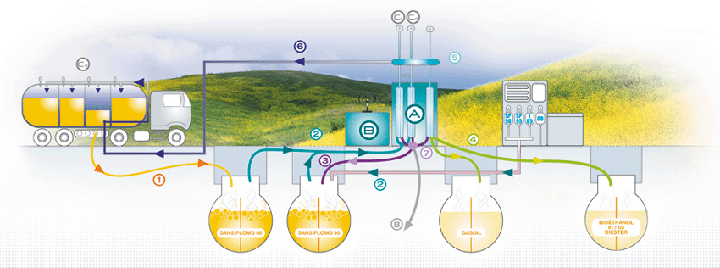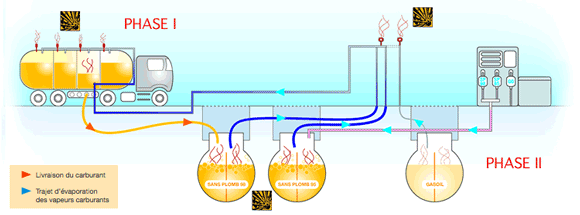OPTIMGAZ IP Network
For achieving optimum performances, the system communicates every operational information to the Network Operation Center (N.O.C) using Internet or GPRS network.
These data are allowing us to monitor and maintain the system.
In addition, the system gives the information concerning the quantity of recovered fuel.
OPTIMGAZ Principle V3 & current V4
Experience has shown that all vapors in service stations escape during unloading
There are never vapors emitted outside of unloading, even in service stations equipped with stage 2 vapor recovery.
This is why our VRU Optimgaz Vapor Recovery Unit by condensation is designed with sufficient cooling capacity to treat high flow rates (45 to 50 m³ / h)
The universal laws of physics make that this power must be 10 KW to maximize the recovery by condensation at -35 or -40 ° C with the high flow rate of the unloading.
Equipped with heat exchangers, Optimgaz strongly cools the gases to temperatures allowing most of the V.O.C. to return to the liquid phase.
Optimgaz is only activated, automatically or manually, during unloading operations. Despite its power, its electrical energy consumption is therefore very modest.
OPTIMGAZ is cooling the vapors at extreme low temperatures which convert the major V.O.C. quantity (Volatile Organic Compounds) to liquid state with fuel characteristics.
This fuel is reintroduced into the underground tank at the service station.
Thus the truck collects vapors which hardly contain any fuel vapors.
NB: A moderately powerful machine would not be very efficient.

fuel vapours emissions

Petrol contains volatile organic compounds (V.O.Cs) that evaporate in storage tanks.
During unloading of petrol to an underground storage tank or refueling of a vehicle, petrol vapour in the tank will be displaced by the incoming petrol.
The regulation is requiring the petrol station company to collect the underground storage tank vapors towards the truck that is delivering the fuel. (Phase 1)
Unless controlled, the petrol vapour will dissipate into the atmosphere.
The regulation is also requiring to collect the refueling vehicles vapors and to send them towards the underground storage tank. (Phase 2)
Then those vapors will be collected by the truck during the next fuel unloading (Phase 1)



